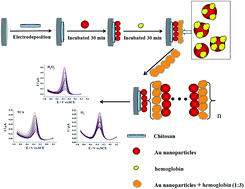Fabrication of highly stable and sensitive electrochemical sensor from hemoglobin–Au nanocomposites and its analytical applications†
Abstract
To improve electron transfer, a combination of electroactive hemoglobin (Hb) and Au nanoparticles (Au NPs) was designed to obtain nanocomposites (NCs). Cyclic voltammetry and redox probe characterization showed that Hb–Au NCs incorporating the layer-by-layer technique to improve the ration of electroactive Hb, showed a better conjugated structure, lower standard entropy, and faster electron transfer. Au entrapped in Hb on the glassy carbon electrode (GCE) also exhibited a wider linear range, and excellent reproducibility and recovery for analytical applications of hydrogen peroxide, oxygen, and trichloroacetic acid. Therefore, our research could potentially become a promising alternative by combining bioactive molecules with nanoparticles, and broaden the applications of mediator-free biosensors.



 Please wait while we load your content...
Please wait while we load your content...